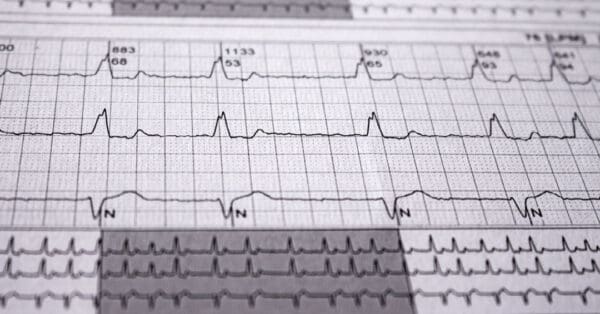|
Persistent AFib Breakthrough | Smartphone Stethoscope App
October 27, 2022
|
|
|

|
|
Together with
|

|
|
|
“When God closes an aortic valve, he opens a mitral valve. Amen.”
|
|
A highlight from Dr. Glaucomflecken’s recent cardiology interview skit.
|
|
|
Surgeries & Interventions
|
|
|
|

|
|
The cardiology community is revisiting how best to treat patients with persistent AFib in light of new evidence that suggests targeting low-voltage areas in the left atrium may be a valuable addition to pulmonary vein isolation.
The self-funded ERASE AF study found that targeting low-voltage areas in the left atrium in addition to pulmonary vein isolation (PVI) effectively improved AFib suppression.
When AFib is persistent, there is often structural atrial disease present which impedes conduction, causing PVI to underperform in these patients. And yet, before the present ERASE AF trial, evidence suggested that additional ablation beyond PVI did not improve outcomes (STAR-AF-2, DECAAF-2, STABLE-SR-II).
In the present trial, 324 patients with persistent AFib were randomly assigned to either PVI alone or PVI plus substrate modification (PVI + SM) groups. SM is an ablation technique that isolates any areas of low voltage.
- Those who received PVI + SM were 38% less likely to experience a recurrence of AFib that lasted 30 seconds or more.
- An analysis of patients with implanted loop monitors (the most sensitive AFib detection monitor) also found less AFib in the PVI + SM group compared to the PVI alone group (55% vs. 39%).
- Adverse events were slightly more likely in the PVI + SM group compared to the PVI alone group (3.7% vs. 1.8%), but the difference was not statistically significant.
The Takeaway
The debate around persistent AFib treatment has continued among electrophysiologists for decades. Contrary to existing evidence that shows additional ablation beyond PVI has no benefit, this RCT found that electrically isolating areas of low-voltage did improve AFib suppression. Although this study alone probably isn’t enough for EPs to wholeheartedly embrace the more aggressive ablation strategy, these findings will likely inform future AFib ablation trials.
|




|
|
Automating the Fight Against Heart Disease
See how Dr. Carolyn Lam evolved from a women’s heart health trailblazer to co-founding Us2.ai and automating the fight against heart disease.
|
|
A New Standard of Cardiovascular Care
Heart disease is the leading cause of death, so it might be time to change how we think about heart attack prevention. Read Cleerly’s manifesto on why our current approach is unsustainable, how Cleerly’s AI-based platform can transform care, and what it will take to change today’s unacceptable heart disease statistics.
|
|
- TEER for Cardiogenic Shock: Transcatheter edge-to-edge repair (TEER) reduced mitral regurgitation (MR) and boosted survival in 3.2k cardiogenic shock patients. At one year after TEER, device success (defined as MR reduction of >1 grade and a final MR grade <2+) was associated with lower all-cause mortality (34.6% vs. 55.5%) and a lower composite of mortality or HF admissions (29.6% vs. 45.2%).
- Smartphone Stethoscope App: A study found that the Echoes smartphone app can capture diagnostic-quality heartbeat recordings, paving the way for cardiologists to monitor cardiac patients remotely. A total of 1.1k participants contributed 7.6k heart sound recordings, and over 80% of users were able to make at least one good-quality recording regardless of gender, BMI, or phone hardware.
- Plant Omega-3s May Boost HF Prognosis: An observational study found that heart failure patients with high serum levels of the omega-3 fatty acid found in plants, alpha-linolenic acid (ALA), had a better prognosis than those with the lowest levels. Researchers analyzed data from 905 HF patients (median follow-up: 2.4 years) and found that patients in the three upper quartiles of ALA levels were 49% less likely to die from cardiovascular disease and 39% less likely to die of any cause or be hospitalized for heart failure than those in the lowest quartile.
- Veterans & Intensified Lipid-Lowering Therapy: A new AHA study revealed that many veterans are undertreated following an ASCVD event, despite the high risk of a recurrent event. Among 81k MI or coronary revascularization events in VA patients, few veterans received lipid-lowering therapy intensification within 14 days, 3 months, and 12 months after the event (33.3%, 41.9%, & 47.3%).
- Intracoronary Imaging Use to Optimize PCI: A new study in Circulation suggests that hospital culture and physician preferences – not patient or procedural factors – largely determine whether intracoronary imaging (ICI) is used to optimize PCI. Among the 48 hospitals included (48.8k PCIs), some reported using ICI in less than 1% of all PCIs, while others had rates up to 75%. Use of ICI optimization was more strongly associated with specific hospitals (odds ratio: 3.48) and physicians (OR: 3.81) performing the PCI than patient or procedural characteristics (aside from left main PCI performance).
- Hospital Occupancy Drives ED Waits: New research in JAMA Network Open showed that higher hospital occupancy was associated with longer ED wait times during the pandemic. Analysis of 2020-2021 EHR data showed that ED wait times lasted more than four hours in 90% of cases when hospital occupancy was greater than 85%, and median wait times were longer than nine hours at the 5% of hospitals with the highest occupancy.
- App Determines CV Risk in Diabetes Patients: Researchers in Italy developed an app called AWARE (available online) that allows clinicians to quickly stratify the cardiovascular risk of patients with type 2 diabetes. The app classified CV risk in 2k patients as very high (72.2%), high (9.9%), or moderate (0.8%). Only about 25% of patients with high or very high risk had been prescribed an SGLT2 inhibitor or a GLP1 agonist, which the 2019 ESC/EASD guidelines recommend as first-line treatment.
- Smartphone Motion Sensors Predict Mortality: Just six minutes of walking data from smartphone motion sensors accurately predicted 5-year all-cause mortality risks. Researchers trained a machine learning model on motion sensor data from 10k UK Biobank participants to estimate the risk of all-cause mortality and then tested the algorithm on the entire cohort (100k participants). The model achieved a C-index of 0.76 and 0.73 at 1 and 5 years. The authors emphasized that although the current research did not directly involve cardiovascular disease, this is the area where it will be most useful.
- CorVista Health’s Breakthrough Designation: CorVista Health announced that its point-of-care tool to assist in the diagnosis of pulmonary hypertension noninvasively received FDA Breakthrough Device designation. The CorVista System (not yet FDA-approved) applies machine learning to a patient’s cardiac and hemodynamic signals to predict cardiovascular disease, and the new designation should put the pulmonary hypertension solution on the FDA fast track.
- Medically Tailored Meals: New research in JAMA found that payers could save $13.6B annually by covering medically tailored meals (MTMs) for patients with diet-related diseases (diabetes, heart failure, cancer) and activity limitations. The study found that among 6.3M eligible Americans, the rollout of MTMs could prevent 1.6M hospitalizations – resulting in $38.7B in avoided healthcare expenditures at an all-in cost of $24.8B for the meals plus delivery.
- Physician Recruitment Challenges: A report from the Association for Advancing Physician and Provider Recruitment highlighted how physicians are becoming harder to replace, as burnout pushes many to exit the industry. The AAPPR analyzed 23k physician hiring searches from last year, finding that 48% of searches were intended to replace departing doctors (up from 32% in 2018), with 33% of physicians citing burnout as their reason for leaving. To compensate for this physician shortage, healthcare organizations are increasingly relying on physician assistants and nurse practitioners, who are more widely available and easier to credential.
|
|
The HeartFlow Story
Shifting the standard of care is a monumental undertaking, and yet physicians across the globe are embracing HeartFlow’s FFRct Analysis. Hear from the co-founder how HeartFlow got its start, and why physicians love it.
|
|
Protecting Your Cardiovascular Imaging Data
Are you sure about your cardiovascular imaging data security? Tune-in to this Change Healthcare webinar discussing how hospital systems and healthcare providers can strategically improve their data security.
|
|
|
|
|